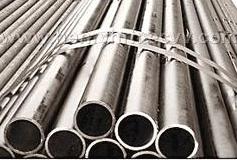 316H Stainless Steel Pipes & Tubes 316H Stainless Steel Pipes & Tubes

Type 316H is a higher carbon variant of 316 making the steel more suitable for use in applications where elevated temperatures are present. Stabilized Grade 316Ti offers similar qualities.
The increased carbon content delivers a greater tensile and yield strength. The austenitic structure of the material also gives this grade excellent toughness, even down to cryogenic temperatures.
The steel lends itself well for use in the petrochemical, gas and chemical industry. Riddhi Impex supply Grade 316H to a variety of customers including fabricators of pressure vessels, industrial boilers and heat exchangers. Benefits of using Type 316H Stainless Steel
- Increased carbon content heat resistant qualities
- Greater tensile yield strength
- Greatershort and long term creep strength
Product Range
Specifications: ASTM A/ASME SA213/A249/A269/A312/A358 CL. I to V ASTM A789/A790
Sizes (Seamless): 1/2” NB - 24” NB
Sizes (ERW): 1/2” NB - 24” NB
Sizes (EFW): 6” NB - 100” NB
Wall Thickness available:
Schedule 5S - Schedule XXS (heavier on request)
Other Materials Testing:
NACE MR0175, H2 SERVICE, OXYGEN SERVICE, CRYO SERVICE, etc.
Dimensions:
All Pipes is manufactured and inspected/tested to the relevant standards including ASTM, ASME and API etc.
Background :
Grade 316 is the standard molybdenum-bearing grade, second in importance to 304 amongst the austenitic stainless steels. The molybdenum gives 316 better overall corrosion resistant properties than Grade 304, particularly higher resistance to pitting and crevice corrosion in chloride environments. It has excellent forming and welding characteristics. It is readily brake or roll formed into a variety of parts for applications in the industrial, architectural, and transportation fields. Grade 316 also has outstanding welding characteristics. Post-weld annealing is not required when welding thin sections.
Grade 316L, the low carbon version of 316 and is immune from sensitisation (grain boundary carbide precipitation). Thus it is extensively used in heavy gauge welded components (over about 6mm). Grade 316H, with its higher carbon content has application at elevated temperatures, as does stabilised grade 316Ti.
The austenitic structure also gives these grades excellent toughness, even down to cryogenic temperatures. |
Composition
Table 1. Composition ranges for 316 grade stainless steel
| Grade |
|
C |
Mn |
Si |
P |
S |
Cr |
Mo |
Ni |
N |
| 316 |
min. |
- |
- |
- |
- |
- |
16.0 |
2.0 |
10.0 |
- |
| max. |
0.08 |
2.0 |
0.75 |
0.045 |
0.03 |
18.0 |
3.0 |
14.0 |
0.10 |
| 316L |
min. |
- |
- |
- |
- |
- |
16.0 |
2.0 |
10.0 |
- |
| max. |
0.03 |
2.0 |
0.75 |
0.045 |
0.03 |
18.0 |
3.0 |
14.0 |
0.10 |
| 316H |
min. |
0.04 |
0.04 |
0 |
- |
- |
16.0 |
2.0 |
10.0 |
- |
| max. |
0.10 |
0.10 |
0.75 |
0.045 |
0.03 |
18.0 |
3.0 |
14.0 |
- |
Mechanical Properties
Table 2. Mechanical properties of 316 grade stainless steel
| Grade |
Tensile Strength (MPa) min |
Yield Strength 0.2% Proof (MPa) min |
Elongation (% in 50mm) min |
Hardness |
| Rockwell B (HR B) max |
Brinell (HB) max |
| 316 |
515 |
205 |
40 |
95 |
217 |
| 316L |
485 |
170 |
40 |
95 |
217 |
| 316H |
515 |
205 |
40 |
95 |
217 |
Note: 316H also has a requirement for a grain size of ASTM no. 7 or coarser.
Physical Properties
Table 3. Physical properties of 316 grade stainless steel in the annealed condition
| Grade |
Density (kg/m3) |
Elastic Modulus (GPa) |
Mean Coefficient of Thermal Expansion (m/m/°C) |
Thermal Conductivity (W/m.K) |
Specific Heat 0-100°C (J/kg.K) |
Electrical Resistivity (n.m) |
| 0-100°C |
0-315°C |
0-538°C |
at 100°C |
at 500°C |
| 316/L/H |
8000 |
193 |
15.9 |
16.2 |
17.5 |
16.3 |
21.5 |
500 |
740 |
Grade Specification Comparison
Table 4. Grade specifications for 316 grade stainless steel
| Grade |
UNS No |
Old British |
Euronorm |
Swedish SS |
Japanese JIS |
| BS |
En |
No |
Name |
| 316 |
S31600 |
316S31 |
58H, 58J |
1.4401 |
X5CrNiMo17-12-2 |
2347 |
SUS 316 |
| 316L |
S31603 |
316S11 |
- |
1.4404 |
X2CrNiMo17-12-2 |
2348 |
SUS 316L |
| 316H |
S31609 |
316S51 |
- |
- |
- |
- |
- |
Note: These comparisons are approximate only. The list is intended as a comparison of functionally similar materials not as a schedule of contractual equivalents. If exact equivalents are needed original specifications must be consulted.
Corrosion Resistance
Excellent in a range of atmospheric environments and many corrosive media - generally more resistant than 304. Subject to pitting and crevice corrosion in warm chloride environments, and to stress corrosion cracking above about 60°C. Considered resistant to potable water with up to about 1000mg/L chlorides at ambient temperatures, reducing to about 500mg/L at 60°C.
316 is usually regarded as the standard “marine grade stainless steel”, but it is not resistant to warm sea water. In many marine environments 316 does exhibit surface corrosion, usually visible as brown staining. This is particularly associated with crevices and rough surface finish.
Heat Treatment
Solution Treatment (Annealing) - Heat to 1010-1120°C and cool rapidly. These grades cannot be hardened by thermal treatment.
|



